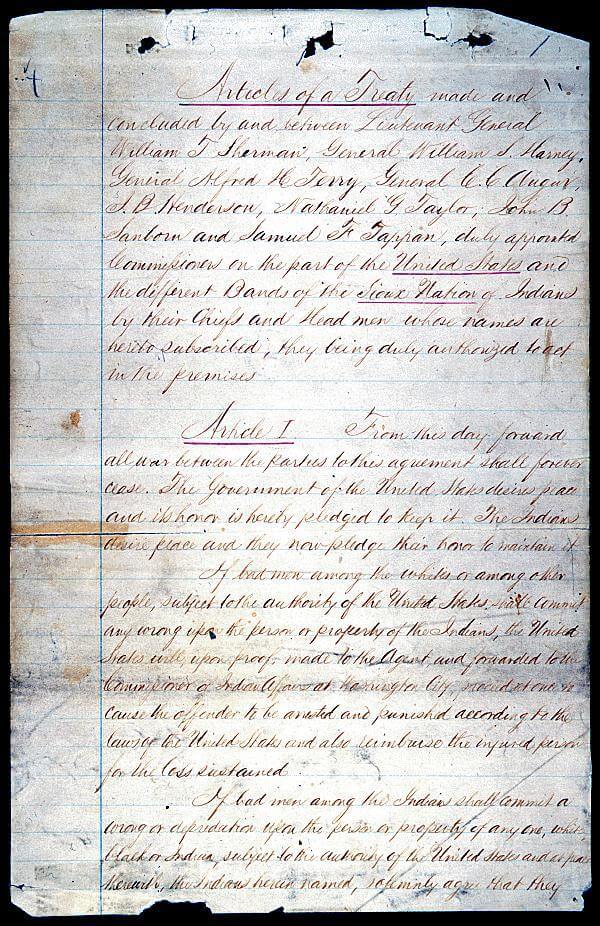
by Deep Green Resistance News Service | Nov 15, 2016 | Colonialism & Conquest
If treaties are the supreme law of the land, as the U.S. Constitution states, then how is it that treaties can be so easily broken by a government that claims to uphold a respect for the law? An even more unsettling question: how is it that the trail of broken treaties has been able to span generations under an outdated, imperial logic unknown to the majority of the U.S. citizens? The founding of the United States is predicated on this painful contradiction between principles of equality and rule of law on one side, and the colonial appropriation of land from native peoples who have inhabited them for millennia, on the other.
The current resistance against the construction of the Dakota Access Pipeline (DAPL) is inscribed in this contradiction, making evident the non-rule of law when it comes to appropriating native lands.
The history of Standing Rock is marked by the history of colonization predicated on the Doctrine of Discovery. The progressive erosion of its Sioux territory goes hand in hand with the logic of terra nullius, which framed land in the Americas as “empty” in order to justify settler colonization.
The Sioux Nation has historically engaged in sovereign government-to-government relations with the US government. The first treaty in which the two parties engaged as diplomatic equals was the Treaty of Fort Laramie of 1851. It was the U.S. government who sought the treaty to allow for safe passage of the influx of settlers travelling west through Sioux territory during the Gold Rush from the east coast to California.
The process of negotiating the Treaty of Fort Laramie followed the colonial settler standard used in contemporary treaty negotiations. While the process was equal in theory to the traditional communal decision-making processes under which many Native Nations operated, the colonial method, which uses elected representatives, heavily favored the interests of the colonial government. Ultimately, the treaty established distinct territories for just under 10 Great Plain tribes. The treaty also permitted settlers to travel on the Platte River Road, achieving the U.S. government’s goal.
The 1851 treaty defined Sioux territory as the land where the DAPL is now being constructed. The territory fell within the western half of modern South Dakota, northwest Nebraska, a portion of northeast Wyoming, and a small part of southeast Montana and southwest North Dakota.
From the very beginning, various parties continuously broke the Treaty of Fort Laramie. Many tribes, unaware of the existence of the treaty, continued to carry out raids on tribes on legally different territories. Furthermore, settlers increasingly trespassed into the treaty territories, disrupting the buffalo hunting grounds of Native Nations. The settlers’ wrongful presence on native land led to various hostile skirmishes and bloody battles in which natives were massacred often without provocation.
But the violation of the Treaty of Fort Laramie didn’t stop there. Over the years, the U.S. government has continued to appropriate Sioux land in an ongoing process of colonization that disregards the treaty. (See map.)
In 1861, the discovery of gold in present-day Montana accentuated the flood of fortune-seekers overrunning Sioux lands in violation of the decade-old Laramie Treaty. Sioux protests to defend their rights and territory were ignored, so the Sioux took matters into their own hands to stop the trespassers. The U.S. responded by sending in a military presence.
Instead of adhering to the terms of the treaty, the U.S. government attempted to negotiate another treaty more preferential to its interests. Treaty making, instead of a diplomatic engagement between two equally powerful sovereign nations had turned into a destructive means of grabbing land and resources from native people; a form of “conquest by law” as per the book by Lindsay G. Robertson.
The result was a second treaty of Fort Laramie signed in 1868. This new treaty shrank the territorial boundaries of the Great Sioux Reservation in exchange for the U.S. federal government’s removal of all existing forts in the Powder River area, among other specifications. Yet it was a flawed treaty from the start. Most importantly, it stipulates that no changes can be made to the legally binding agreement unless ¾ of all adult Sioux males consent. Many members of the Sioux nation, particularly those within the boundaries of the territory signed the treaty. But many more bands residing north of the Bozeman Trail, such as the Hunkpapa and Sihasapa bands, did not. The treaty was not signed by three quarters of all adult Sioux males.
Yet, again, the U.S. government violated the treaty. The second Laramie treaty granted the tribes the right of regulating the entry of persons into their territory. Article II of the 1868 Treaty stipulates that nobody can enter the territory without tribal permission. But time and time again settlers have encroached on Sioux territory.
Some Americans may know that in 1874 the U.S. government sent George Custer with a group of scientists to search for natural resources, especially gold, in the isolated mountain range known today as the Black Hills. The gold they found led to an influx of miners, again in direct violation of the treaty.
Eventually, the U.S. government decided to pursue its strategy of land appropriation without bothering with the pretense of legality. The Sioux learned to be wary of treaties with the U.S. and refused to sign away their land.
In 1877, Congress unilaterally passed an act removing the sacred Black Hills from the Great Sioux Reservation, without the ¾ consent of the Sioux mandated by the Laramie Treaty of 1868. This illegal grab of sacred land brought no legal repercussions to the party that violated the treaty—the U.S. government.
In 1889, Congress again diminished the Great Sioux Reservation with the Dawes Act and Allotment Act, partitioning it into six sections, one of which was the Standing Rock Sioux Reservation. This opened up parts of the reservation to outside settlement, even though the native government still controls all reservation lands.
Sioux struggles for water are embedded in such displacements. In 1948, the U.S. government began construction of Oahe Dam, despite resistance from local tribes. Its creation flooded tribal land and forced a quarter of the reservation’s inhabitants to move.
In 1958, a federal court ruled that Lake Oahe was part of the Standing Rock territory according to the 1868 Fort Laramie Treaty. In this ruling the court said, “Where there is a treaty with Indians which would otherwise restrict the Congress, Congress can abrogate the treaty in order to exercise its sovereign right.” The court openly articulated the self-arrogated right of the U.S. government to go back on treaty obligations with Native Americans to unilaterally exercise its sovereign power.
The U.S. did just that, taking the Lake Oahe land from the Standing Rock tribe through legislation passed by Congress in September 1958 [Public Law 85-915].
Legal abrogation, or repealing legislation, dispenses with any idea of fair treaty making between equals. It undermines native sovereignty, following a racist logic of colonial elimination. It dispenses with numerous prior legal precedents that granted Native Americans some rights, such as the Indian Appropriations Act of 1871, which declared that no treaty obligation with an Indian nation before March 3, 1871 can be “invalidated or impaired.” It puts into question the idea of the “federal Indian trust responsibility,” articulated in the Seminole Nation v. United States case of 1942, which entailed an obligation on the part of the U.S. government to protect tribal treaty rights, land, assets and resources, per the Department of the Interior Indian Affairs branch.
As a federally recognized tribe, the Standing Rock Sioux Tribe is legally entitled to these obligations. However, as history has shown, U.S. principles and laws do not seem to have the same meaning when it comes to Native Americans.
The United States claim that it can abrogate treaties with Native Americans has been upheld by US courts as legal. Law in our modern eyes carries the weight of legitimacy.
But because something is legal does not make it right. In the case of the Sioux, alongside every other Native American nation, laws and treaties have all too often been used not as a protective shield, or even as a neutral arbitrator, but as a weapon. That weapon is predicated on a racist, colonial history that invalidated native people’s rights to their land, to their sovereignty, to their cultural expression, to their very lives.
Whether it is the gold rush or the oil rush, the U.S government continues even now to invade native land and break treaties. The proposed DAPL would pass under Lake Oahe, the land that was openly, “legally” taken from the Sioux tribe in 1958 by Congress, despite the prior 1868 Treaty that had legally granted the Sioux rights to the land.
Today’s protests at Standing Rock today can only be fully understood in light of this colonial legacy, which from the beginning proclaimed that native lands were empty and that native people, were, in effect, nothing more than the rocks, the trees, the water that they now so valiantly strive to protect.
Let us fight against this narrative, and show through Standing Rock that native tribes are sovereign nations that possess the inherent right to life on their territories. Let us show that Native American lands are not empty, but that proud sovereign peoples live there, alongside the earth, water, rocks and trees, wind and sky, encompassing a vibrant fullness in their long defense of life.
There never was terra nullius. The only emptiness to be found exists in the hollow promises of the United States, in the historic lack of equitable substance in the U.S. legal system.
In that spirit, many U.S. citizens are now, finally, refusing to turn a blind eye to the trail of broken treaties. They stand with Standing Rock, and are petitioning President Obama to honor the treaties (petition here): “The Native nations have upheld their end of the bargain; it is time the U.S. government did the same.”
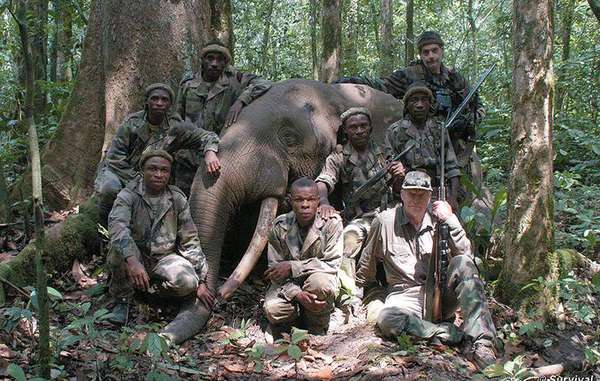
by Deep Green Resistance News Service | Nov 2, 2016 | Biodiversity & Habitat Destruction, Colonialism & Conquest
Featured image: World Wildlife Fund trustee Peter Flack with dead forest elephant. © Survival International
by Survival International
Survival International has learned that an elephant-hunting safari operation jointly owned by a French billionaire has been implicated in human rights abuses against local Baka “Pygmies” and their neighbors, including illegal evictions and torture.
The operation is based in two “protected areas” in Cameroon, leased by Benjamin de Rothschild. It offers tourists the chance to pay €55,000 to shoot a forest elephant.
Baka were evicted from their ancestral land to create the trophy hunting operation, contrary to international law. It is patrolled by soldiers, police and armed guards, and Baka have now been told they will be shot on sight if they cross it to hunt to feed their families, gather plants, or visit religious sites.
The Baka report that three of their forest camps have been burnt by wildlife guards and safari camp employees in the last year alone. Baka men hunting for food in this forest have been beaten by local police, soldiers and wildlife guards.

Benjamin de Rothschild, joint owner of a luxury elephant-hunting operation on Baka land
© JeuneAfrique
One Baka man told Survival: ”They told me to carry my father on my back. I started walking, [the guard] beat me, he beat my father. For three hours, every time I cried out they would beat me, until I fainted and fell to the ground with my father.”
Another Baka man said: “When the trophy-hunting company finds us here they burn the camps. They beat us, they search for us, they set their dogs on you, their guns on you.”
A third Baka said: “The trophy-hunting company said that if they see anyone [in the forest] bullets will fly. Now those who have family there have gone to get them out. How will we live now?”
Survival contacted Mr. de Rothschild informing him of reports of serious human rights abuses having been committed to maintain the trophy-hunting operation, but has received no reply.
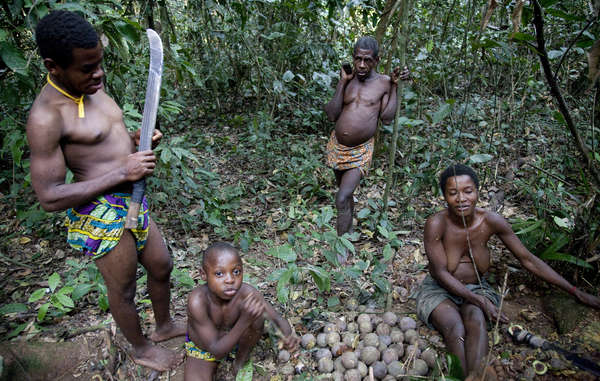
The Worldwide Fund for Nature (WWF) is very active in Cameroon, and the trophy-hunting “protected areas” form part of one of their key “conservation landscapes.” WWF has yet to comment on the allegations, or say whether it proposes to take any action.
One booking operator told Survival that: “All our luxurious fully equipped forest camps are solid construction, air conditioned with private chalets with full bathrooms and dressing parlors. Delicious multi-course cuisine is served with top shelf European wines and beverages… Our newest forest camp has a large screened in swimming pool.”
Watch: Baka plead for forest guards to leave them in peace.
© Survival International
Across the region, Baka “Pygmies” and their neighbors are being evicted from their ancestral homelands and face arrest and beatings, torture and even death while big game trophy-hunting is encouraged. WWF trustee Peter Flack has also hunted elephants in the region.
Survival’s Director Stephen Corry said: “Across Africa, rich trophy hunters are welcomed into the same areas where tribal hunters are illegally evicted from their ancestral homelands and brutalized for hunting to feed their families. This has to stop. Conservation in the Congo Basin is land theft, a continuation of colonialism. It leads to widespread and horrific human rights violations, including extrajudicial killing. Why are so few people speaking out? Survival is leading the fight against these abuses. Conservationists must respect human rights like everyone else is supposed to.”
Click here to find out more and take action.
This is not an isolated incident. Across Africa, tribal people are accused of “poaching” because they hunt to feed their families. And they face arrest and beatings, torture and death, while big game trophy hunters are encouraged. Survival International is leading the fight against these abuses.
Note: “Pygmy” is an umbrella term commonly used to refer to the hunter-gatherer peoples of the Congo Basin and elsewhere in Central Africa. The word is considered pejorative and avoided by some tribespeople, but used by others as a convenient and easily recognized way of describing themselves.

by Deep Green Resistance News Service | Nov 1, 2016 | Repression at Home
by Steve Horn / Desmog
TigerSwan is one of several security firms under investigation for its work guarding the Dakota Access pipeline in North Dakota while potentially without a permit. Besides this recent work on the Standing Rock Sioux protests in North Dakota, this company has offices in Iraq and Afghanistan and is run by a special forces Army veteran.
According to a summary of the investigation, TigerSwan “is in charge of Dakota Access intelligence and supervises the overall security.”
The Morton County, North Dakota, Sheriff’s Department also recently concluded that another security company, Frost Kennels, operated in the state while unlicensed to do so and could face criminal charges. The firm’s attack dogs bit protesters at a heated Labor Day weekend protest.
Law enforcement and private security at the North Dakota pipeline protests have faced criticism for maintaining a militarized presence in the area. The American Civil Liberties Union (ACLU) and National Lawyer’s Guild have filed multiple open records requests to learn more about the extent of this militarization, and over 133,000 citizens have signed a petition calling for the U.S. Department of Justice to intervene and quell the backlash.
The Federal Aviation Administration has also implemented a no-fly zone, which bars anyone but law enforcement from flying within a 4-mile radius and 3500 feet above the ground in the protest area. Dallas Goldtooth, an organizer on the scenes in North Dakota with the Indigenous Environmental Network, said on Facebook that “DAPL private security planes and choppers were flying all day” within the designated no-fly zone.
Donnell Hushka, the designated public information officer for the North Dakota Tactical Operation Center, which is tasked with overseeing the no-fly zone, did not respond to repeated queries about designated private entities allowed to fly in no-fly zone airspace.
What is TigerSwan?
TigerSwan has offices in Iraq, Afghanistan, Jordan, Saudi Arabia, India, and Latin America and has headquarters in North Carolina. In the past year, TigerSwan won two U.S. Department of State contracts worth over $7 million to operate in Afghanistan, according to USASpending.gov.
TigerSwan, however, claims on its website that the contract is worth $25 million, and said in a press release that the State Department contract called for the company to “monitor, assess, and advise current and future nation building and stability initiatives in Afghanistan.” Since 2008, TigerSwan has won about $57.7 million worth of U.S. government contracts and subcontracts for security services.
Company founder and CEO James Reese, a veteran of the elite Army Delta Force, served as the “lead advisor for Special Operations to the Director of the CIA for planning, operations and integration for the invasion of Afghanistan and Operation Enduring Freedom” in Iraq, according to his company biography. Army Delta partakes in mostly covert and high-stakes missions and is part of the U.S. Joint Special Operations Command (JSOC), the latter well known for killing Osama Bin Laden.
One of TigerSwan’s advisory board members, Charles Pittman, has direct ties to the oil and gas industry. Pittman “served as President of Amoco Egypt Oil Company, Amoco Eurasia Petroleum Company, and Regional President BP Amoco plc. (covering the Middle East, the Caspian Sea region, Egypt, and India),” according to his company biography.
“Sad, But Not Surprising”
Investigative journalist Jeremy Scahill told Democracy Now! in a 2009 interview that TigerSwan did some covert operations work with Blackwater USA, dubbed the “world’s most powerful mercenary army” in his book by the same name. Blackwater has also guarded oil pipelines in central Asia, according to Scahill’s book.
Reese advised Blackwater and took a leave of absence from TigerSwan in 2008 in the aftermath of the Nisour Square Massacre, a shooting in Iraq conducted by Blackwater officers which saw 17 Iraqi civilians killed. TigerSwan has a business relationship with Babylon Eagles Security Company, a private security firm headquartered in Iraq which also has had business ties with Blackwater.
“It is sad, but not surprising, that this firm has ties to the US interventions in Afghanistan and Iraq,” Medea Benjamin, co-founder of the women-led peace group CODEPINK and the co-founder of the human rights group Global Exchange, told DeSmog. “It is another terrifying example of how our violent interventions abroad come home to haunt us in the form of repression and violation of our civil rights.”
The North Dakota Bureau of Criminal Investigation and the Private Investigation and Security Board are also conducting parallel investigations to the one recently completed by Morton County. TigerSwan did not comment on questions posed about their contract.
Featured image credit: Flickr / Chuck Holton
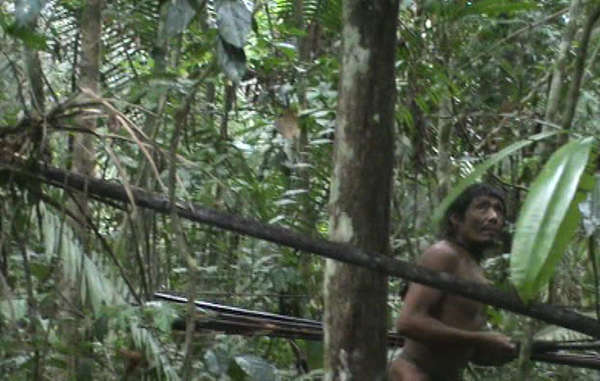
by Deep Green Resistance News Service | Oct 28, 2016 | Colonialism & Conquest
by Survival International
Waves of loggers are invading the territory of one of the most vulnerable peoples on the planet. The Indians, known as the Last of the Kawahiva, are the survivors of a larger tribe who have been killed or died of disease.
One group of loggers was recently caught by agents from FUNAI, Brazil’s Indigenous Affairs department. However, as the loggers have local political support, and FUNAI agents do not have the power to arrest suspects, the men were released. Further waves of loggers have since entered the territory.
The crisis has raised concerns among campaigners that the tribe and their rainforest home could be destroyed entirely.
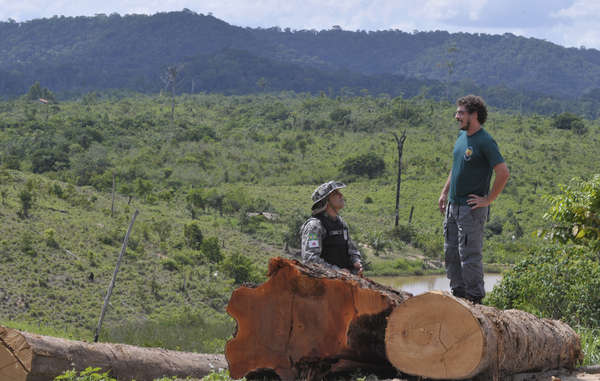
FUNAI agents work in many parts of Brazil to protect indigenous territories from loggers and other threats. © Mário Vilela/FUNAI
In April 2016, the Brazilian Minister of Justice signed a decree to create a protected indigenous territory on the tribe’s land to keep loggers and other intruders out. This was a big step forward for the Kawahiva’s lands and lives, and followed pressure from Survival’s supporters around the world. However, the decree has yet to be properly enacted and now the small team who are working to protect the land are facing severe budget cuts.
Jair Candor, an experienced FUNAI agent, said: ”The Kawahiva are trapped. If any contact happens, it will be devastating for them. The only way to ensure their survival is to map out the land and put in place a permanent land protection team. Otherwise, they will be relegated to the history books, just like so many other tribal peoples of this region.”
Oscar-winning actor Mark Rylance has narrated a film to highlight the tribe’s plight.
Survival’s Director Stephen Corry said: “Brazil committed to protecting the Kawahiva’s land in April, but with the government dragging its heels an urgent and horrific humanitarian crisis is unfolding. The Kawahiva’s land is still being invaded and their forest is still being destroyed. It’s time for Brazil to take action as it promised, before the genocide of an entire people is complete.”
by DGR News Service | Oct 16, 2016 | Rape Culture
Society must choose whether women count as human
Lierre Keith / Deep Green Resistance
Feminism has always been a contested area of politics. Fierce arguments centre on what it is, and why we need it. The best definition I know is from Andrea Dworkin: “Feminism is the political practice of fighting male supremacy on behalf of women as a class.” In one elegant sentence, she names both the problem ― male supremacy ― and the solution ― political action.
Implicit in those 16 words are also the two requirements of the human heart: love and hope. It is an act of love to notice women. Women are on display everywhere of course ― naked, for sale, the coin of the realm in a pornographic culture ― but being an object is the opposite of being human. Noticing the harm that is being done ― insisting that it is harm ― starts from love.
Such noticing tends to have an inverse relationship to hope. When harms against a people are both vicious and everyday, hope becomes a combat discipline. But, whether grim or glad, hope is possible only because change is possible. This is the promise of feminism: as endless as the horrors seem, they could end. We, as a society, could end them.
Armed with love and hope, I travelled to London recently for a conference on male violence and how we might end it. I left the US still braced against the details that had come out of Ohio: three women, one six-year-old girl, a basement strung with chains ten years long.
I arrived in London to news of Mark Bridger’s trial: his catalogue of images of murdered girls, his library of sadistic child-porn, the stalking that escalated from online to real life. This meant real death to a perfect promise of a girl named after spring. Her parents are now condemned to a deep winter of grief; how they will survive is anyone’s guess.
Then there was the long fall of Chevonea Kendall-Bryan, the 13-year-old who fell to her death from the window of her home, having suffered sexual bullying. Longer still was the fall from human to object, through rape, and more rape, landing finally on the unyielding surface of complete public violation. Does it matter whether she jumped or fell? Her life was shattered either way.
This is where we stand or fall as a society. We will have to choose. Right now, our society is choosing to make cruelty normal. We are choosing saturation in sadism. The choice turns on whether women count as human.
A few brute facts will answer. Globally, one in three women will be raped or beaten in her lifetime. Half of all sexual assaults are committed on girls under 16: might as well start the lesson early. In the UK, a woman is raped every nine minutes. There are plenty more numbers, and inside each and every one are the broken shards where body and soul, self and world, once met.
The numbers should speak for themselves, but numbers don’t actually speak, of course. They need human voices to carry them. The result of subordination, though, is always silence. Silence is what happens when people are turned into objects. Violence will do that. Sexual violence especially will do that. Sexual violence against children is a shroud of silence that can take a lifetime to unwind.
Amnesty International reports that rape is the most traumatic form of torture. In fact, women who have survived prostitution have higher rates of post-traumatic stress disorder than soldiers who have survived combat, which is to say that the war men are waging against women is in many ways worse than the wars they inflict on each other.
If you need convincing, type the word “rape” into Google images. Or, if you have the stomach and the spiritual stamina, try “torture porn”. What you will see is not entertainment, or sex, or freedom. What you will see is hell. What you will also see is that men by the million have been there before you.
We need feminism because, without it, the realities of women’s lives are unspeakable ― each woman cut adrift in a hostile, chaotic sea. Apply feminism, and that chaos snaps into a sharp pattern of subordination ― from the small, daily insults to body and soul, to the shattering traumas of incest and rape.
The crimes that men commit against women are not done to women as random individuals: they are done because women belong to a subordinate class, and they are done to keep women a subordinate class.
None of this will change unless we face the truth. I wrote above that every nine minutes a woman is raped. That is hard enough, but it is not the truth. This is: every nine minutes a man rapes a woman. And I am left with a human howl of “Why?” After 30 years spent fighting male violence and pornography, I still have no answer.
I am a feminist because I think women count as human. But feminism also insists on the humanity of men: we think that men can do better. The anthropologist Peggy Reeves Sanday studied 95 societies, and found that almost half were rape-free. It is not random. It is actually rather straightforward. Rape-free cultures value co-operation whereas rape-prone cultures reward competition. In the former, political and economic power are shared by the sexes; in the latter, women are dispossessed.
Whereas in the one, the sacred has both female and male aspects, in the other, God is only ever male. And now we come to it: in rape-free cultures, anyone can assume positions of ceremonial importance. In rape-prone cultures, men exclude women from roles of spiritual intercession.
Social subordination is like a set of concentric circles. The innermost is where the worst occurs: the cattle cars, the severed limbs, the missing girls found as bone fragments and blood stains. But every circle in the set helps to constrain the people trapped inside. The outer rings shore up the inner horrors, making them both normal and invisible.
How can such things happen, we ask in anguish? They can happen because each successive circle ― each institution and social practice ― creates the bull’s eye where Chevonea landed and April will never be found.
We have a choice, as individual men and women, and as a society. We can keep other humans barricaded inside such atrocities, or we can bring those barricades down. Either women will finally count as human, or the rancid pleasures of sadism will continue to rot our society and our souis. Choose now, before another girl falls, and another goes missing.
Originally published in the June 28, 2013 issue of Church Times

by Deep Green Resistance News Service | Oct 11, 2016 | Colonialism & Conquest
by Anne Keala Kelly
It’s a twofer.
With a Thanksgiving holiday release of “Moana,” Disney’s Polynesian cartoon extravaganza can simultaneously expand its lucrative enterprise of exploiting marginalized, indigenous peoples (Pocahontas, Lilo and Stitch, Frozen) while perpetuating American amnesia.
A note about Thanksgiving: Early feasts of giving thanks celebrated some notable atrocities committed against Native peoples, including the 1637 massacre of 700 Pequot Indians by white Christians and the 1676 butchering and beheading of Wampanoag Sachem Metacom, whose severed head was then displayed on a pike for 25 years at Plymouth. Ultimately it was President Abraham Lincoln who declared it a national holiday in 1863, less than a year after he ordered the hanging of 38 Dakota men, which remains the largest mass execution in U.S. history.
Given the pre-Halloween rollout of the Maui skin suit so that children would unwittingly promote “Moana” like human billboards, I doubt the choice of a release date was any less thought out. Some of the most experienced and powerful business minds in the world own and operate Disney — they’re not the type to leave a hundred-something million-dollar investment to chance.
Opening dates, promotion, and merchandising are carefully planned well in advance to achieve maximum financial gain. The skin suit and Thanksgiving release shouldn’t be thought of as unintended cultural faux pas — these were calculated risks. To give the benefit of the doubt to a $50-billion corporate predator waiting to vacuum up a few billion more off of our culture(s) is to agree with the offense.
Most indigenous peoples under U.S. control, certainly Hawaiians, have yet to carve out a meaningful space to represent ourselves, what we value and our reality in mass media and film largely because America’s master narrative relies on our subjugation. The truth of what matters to us undermines the colonizer’s imagineered innocence. The narrative of Hawai’i as “the Aloha State” is a perfect example — every non-Maoli living and vacationing here is able to do so because of the theft of our nationhood and the complete appropriation and subversion of our land and culture.
While there are certainly other oppressed groups, our oppressions aren’t any more equal than our successes. Hawaiian world—indigenous world is all buss up, and our narratives are convoluted. But the settler world isn’t, and neither is its story.
Our hopes, dreams and struggles are inconvenient to what Disney has chosen to produce about us. Worse yet, we’re expected to shut up and enjoy the ride everyone’s taking on our back. Yes, some of our own people, grateful for any acknowledgment, don’t recognize an insult or culture theft when they see it. Others will happily join in with the massive, commodifying monstrosity of “Moana” and buy Moana gear and computer games. (I heard that the Ala Moana Disney Store is already well-stocked.)
One Maori writer, who likes the Maui skin suit, said it’s like dressing up as Santa Claus. He’s not far off, seeing as how we’re the ones doing all the giving. He reminded me of something funny that Haunani-Kay Trask, one of our beloved sovereignty leaders, once said to me: “Yah, the haole, they stole everything we gave them.”
Being culturally poached and misrepresented isn’t flattering — it’s a threat. The historical fact is that colonization in the Pacific, and everywhere for that matter, has had catastrophic consequences for indigenous peoples in every conceivable way. And native collaboration, while highly problematic, doesn’t legitimize hijacking or pimping our knowledge, heritage and identity.
Having said that, not knowing who the members are of the Oceanic Story Trust, a group that was hand picked by Disney to shepherd the cultural content and merchandising, we can’t ask these Pacific Mouseketeers what the capital F they were thinking when they helped Disney strip mine our culture(s) for the sole purpose of making a profit.
Although bad publicity in the form of complaints that the skin suit is racist motivated Disney to take it off the shelf, they did it with a condescending, “We regret that the Maui costume has offended some,” version of an apology. I suppose that’s the best we can expect from an entity whose bottom line is protecting its investment.
But Hawaiians and other indigenous Pacific Islanders are the ones who need to think hard about what something of this magnitude will mean. Given that it’s shaping up to become this region’s cultural heist of the century (so far), we may want to try to make native sense of the intent and the processes at work here, especially us Hawaiians.
I say especially Hawaiians because so much is being done to us politically, materially, culturally and spiritually these past few years. From the mass desecration project of the Thirty Meter Telescope to the Obama administration’s determination to force feed us federal recognition against our will, ours is a never-ending struggle to simply survive in our homeland as who we are.
The cultural imperialism of Disney mirrors the military imperialism of the United States and the other industries it uses to erase our indigenous belonging: tourism and real estate. Disney’s Aulani Resort, and now its “Moana,” secures its place in the economically enforced ethnocide and culturcide that is steadily replacing us with settlers.
If the promotional trailer is anything like the film, Disney’s about to get even richer by exploiting and mocking us in deeply genealogical and spiritual ways—turning Tutu Pele into an ugly lava monster and Maui into a ridiculous, clowning sidekick. The noted psychiatrist, philosopher, revolutionary and writer Frantz Fanon was so on the mark when he said, “… Colonialism is not satisfied merely with holding a people in its grip and emptying the native’s brain of all form and content. By a kind of perverted logic, it turns to the past of the oppressed people, and distorts, disfigures and destroys it.”
Disney has reduced us and our world to a cartoon at a time when our political future is hanging in the balance, when Hawaiians absolutely need to be heard and taken seriously, not distracted by or silenced for entertainment. Disney is trying to do to our culture and identity what America is doing to our land and nationhood: we are being carved up, sold off, and drained of our mana.
Since the Maui skin suit debacle, Disney’s 21st century iteration of the white supremacist ideology that informed people like British Major General Horatio Gordon Robley, a proud collector of Maori heads, and that guy who tried to sell a Hawaiian kupuna skull on E-Bay, I’ve been thinking in metaphors. I’m looking at what’s happening right now, but looking, too, at the horizon, at what’s coming toward us, imagining what might follow, hoping that whatever it is, Hawaiians and all Pacific Islanders can face it together instead of letting it further divide us.
I have no doubt that Disney’s “Moana” will materially and psychologically aid and abet the colonial project of indigenous erasure and removal. It’s a cultural tsunami and it will impact the entire region. However, unlike natural disasters, this man-made disaster will play out over many months and years and will continue for as long as Disney can suck the marrow from our spiritual and cultural bones.
Anne Keala Kelly is the award winning filmmaker of “Noho Hewa: The Wrongful Occupation of Hawai‘i,” and a journalist whose work has appeared in The Nation and Indian Country Today, and on the Pacifica Network and Al Jazeera.








